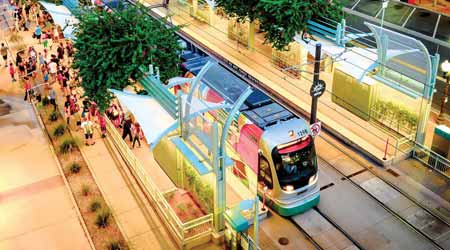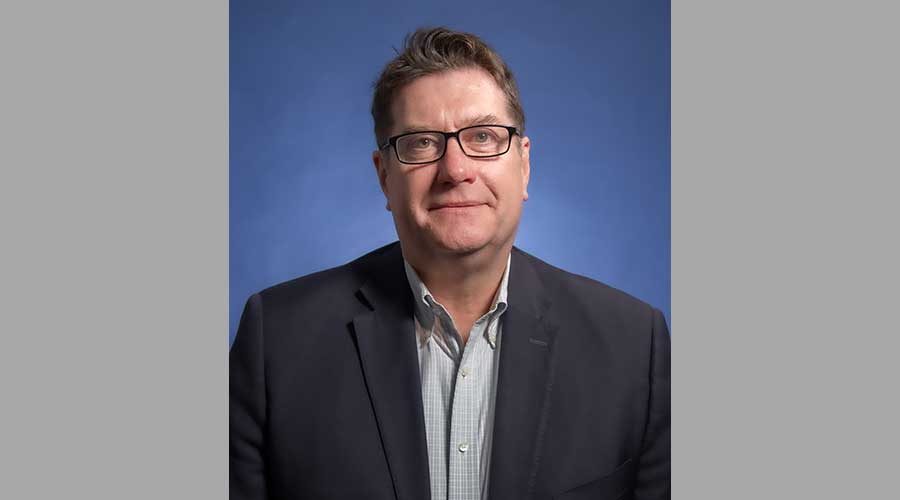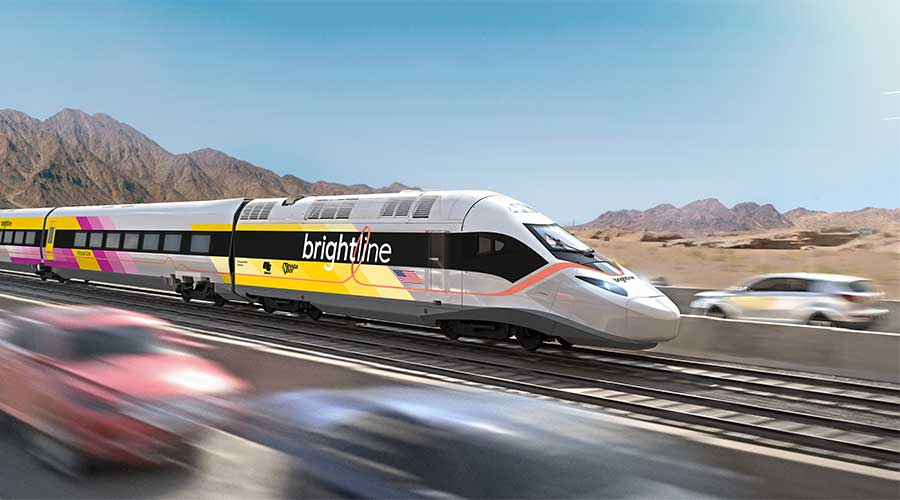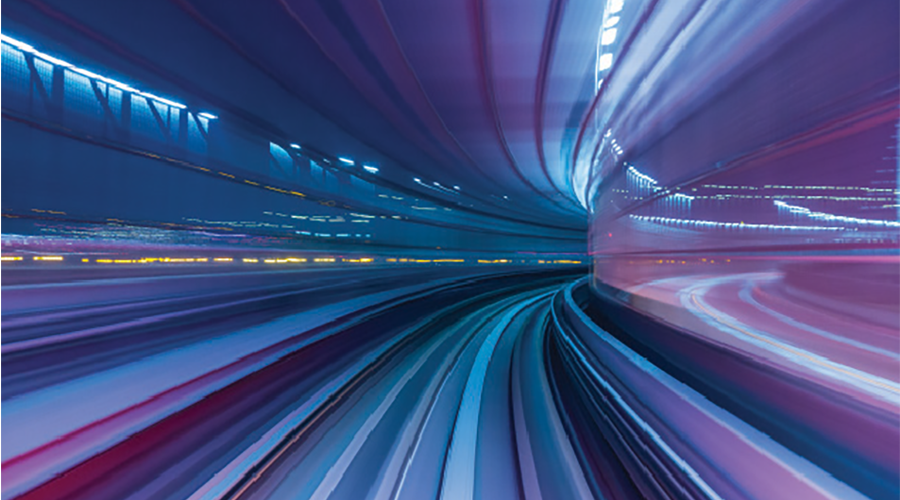Stay updated on news, articles and information for the rail industry
June 2016
Rail News: Passenger Rail
Valley Metro is pursuing a bold expansion plan in metropolitan Phoenix

— by Julie Sneider, senior associate editor
Valley Metro has been on a roll. In less than 18 months, the Arizona public transit agency serving the Phoenix-Mesa-Tempe area has opened two light-rail extensions as part of its aggressive plan to build 66 miles of light rail by 2034. The agency also has logged steady growth in rail ridership — including serving a record number of passengers during Super Bowl XLIX — and received word earlier this year that Tempe's streetcar proposal has been included in President Obama's fiscal-year 2017 budget.
Moreover, in August 2015, Phoenix voters approved a referendum calling for a major boost in local transit funding, including additional dollars that will help pay for new Valley Metro light-rail lines.
At the same time the agency has logged a good deal of light-rail success in its relatively short history — Valley Metro Rail Inc. was founded in 2002 — it also hit a few speed bumps. The biggest hit came in late 2015, when then-Chief Executive Officer Stephen Banta stepped down after The Arizona Republic launched an investigation into his entertainment and travel expenses while at the agency.
In response to Banta's resignation, Valley Metro's board tapped former Mesa Mayor Scott Smith to fill in as interim CEO. A lawyer, accountant, former real estate developer and longtime advocate of public transit, Smith has spent the past few months trying to right the agency’s course so that Valley Metro staff members can refocus their attention to growing and operating a public transportation system that serves the valley region.
Balancing a full plate
Since he arrived on the scene Feb. 1, Smith has taken steps to correct the problems uncovered in a recent audit of the agency, improve employee morale and keep staff focused on advancing the agency’s expansion plans.
"I was recruited to come in, hopefully settle things down, deal with the issues that came out of the departure of our former CEO and work to restore trust in the agency," Smith says. "We've been working on initiatives to accomplish all three of those."
In late April, an audit of the agency — which Phoenix city officials ordered in response to the Arizona Republic's reports on Banta's spending — determined there was more than $315,000 in unallowable or questionable expenses by Banta and some Valley Metro staff members. Among the audit's findings: expenses that lacked supporting documentation; staff members who worked for Banta approved additional pay for him so he could avoid paying taxes on relocation expenses; time off that wasn’t counted as vacation time; and he never signed the agency’s ethics policy, the Republic reported. In addition, the audit found that Valley Metro’s board didn't have a written policy on awarding bonuses, which resulted in a potential overpayment to Banta.
"Deficient controls over staff-related expenditures resulted in consistent CEO and staff non-compliance with travel and business-expense policies and misuse of funds," the audit stated.
An Arizona Attorney General's Office criminal investigation of the situation is now underway. To correct the audit-identified problems, Smith and the board have put into place new policies that establish clear lines of authority, ensure Valley Metro leaders are held accountable to the same procedures that other employees must follow, and require that travel and other expenses charged to the agency are adequately documented and for approved business purposes only. Those things weren't happening at Valley Metro before the controversy arose, according to Smith. "The audit definitely exposed why the breakdown occurred," he says. "What we implemented [since the audit] are things that should be present in any organization — government or private. … I don't want to say the fixes were simple or easy, but the gaps [in procedure] were glaring and readily identifiable."
Moving forward
Employee morale also has suffered as a consequence. But now that the audit is out and he and the board have begun to implement new policies, Smith hopes the worst is behind them.
"Let's move forward on the things that need to be fixed, and then focus on our real mission, which is building and operating a light-rail system," he says.
In an effort to restore the public's trust, Smith has been out talking to people in the community as much as possible. Based on feedback from local citizens, he believes the public wants Valley Metro to succeed at its mission.
"People in metro Phoenix have not only accepted light rail, they've embraced it," he says. "From our original 21 miles [opened in December 2008] we've extended the light-rail system to 27 miles on our way to building a 66-mile system."
Making light rail the goal
To that end, the agency has been on a fast track since 2002, when Valley Metro Rail Inc., a nonprofit public corporation, was founded for the purpose of planning, building and operating a 66-mile regional light-rail system by 2034. Valley Metro's rail board member cities include Phoenix, Tempe, Mesa, Glendale and Chandler, but only Phoenix, Tempe and Mesa currently have light-rail service.
The first train began serving passengers on a 20-mile starter line in 2008; today, the agency's 50 Kinkisharyo-manufactured vehicles operate on about 26 miles of rail.
In August 2015, Valley Metro opened the 3.1-mile Central Mesa Extension, which connects downtown Mesa businesses, the arts and entertainment district, Mesa City Plaza, Phoenix Sky Harbor International Airport and special events in downtown Tempe and Phoenix. Valley Transit Constructors began building the extension in summer 2012. The project was funded by a $75 million grant from the Federal Transit Administration (FTA), $71 million in countywide transportation tax funds and $53 million in federal air quality funds.
And on March 19, 2016, Valley Metro opened Northwest Phase I, a 3.2-mile route along 19th Avenue from Montebello to Dunlap avenues, with stops at three stations. Construction began on the $327 million project in January 2013, with funding covered by the Maricopa County-wide Proposition 400 transit sales tax and funds from Phoenix’s Transit 2000 program. The city of Phoenix covers the cost of operating light rail within its own borders.
Valley Metro staff members are used to challenges. But planning, constructing and operating a 20-mile starter line and expanding it 6 more miles in less than 10 years was formidable to say the least, according to Smith.
When the agency’s first rail segment opened in 2008, it was the largest new construction and single-day opening of a light-rail system in U.S. history, he says.
"We took on a big chunk of responsibility to begin with," Smith says. "And, while we were all excited to open a new rail system in late 2008, remember what also was happening in 2008: We were in the tailspin of the Great Recession. That put huge pressure on our regional funding, which funds a large chunk of our bus service."
The economic downturn led to the need for a significant restructuring of the agency’s bus routes to address the loss in revenue. During that time, two different areas of focus among employees evolved. One was full of excitement and focused on the new rail system and plans for future growth; and the other was focused on redrawing bus routes, schedules and maps to match the recession-related loss of revenue.
"That was a unique challenge that the organization was able to handle," Smith says. "But despite all those strains and pressures, from an operational standpoint the staff here has done an incredible job in continuing to build those two light-rail extensions, which is about a 30 percent expansion of our system, while also continuing to run our trains on time."
And all of that was managed within the agency's complex organizational structure. Valley Metro is made up of two legal entities: the Valley Metro Regional Public Transit Authority (RPTA) and Valley Metro Rail Inc. Although each has its own board that oversees different public transportation services, the systems are managed by the same staff and CEO.
As the rail system has grown, so has Valley Metro's ridership, which has increased steadily between 2009 and 2014. When Phoenix played host to Super Bowl XLIX in early 2015, the agency set a ridership record with 126,000 light-rail boardings on Jan. 31, 2015. On an average Saturday, ridership is around 35,000 boardings, according to Valley Metro officials.
When not packed with NFL fans, Valley Metro's trains are typically filled with college-age students — Arizona State University has campuses in Tempe and Phoenix. That younger crowd makes up the largest single demographic group of riders, according to Smith.
And yet, a surprising number of retirees and senior citizens also have been riding the trains, Smith says, adding that seniors have told him they appreciate the convenience of taking the train to venues and events in downtown Phoenix.
"For the college students, it's about the convenience, but the seniors see the train as a freedom provider," he says. "Many find driving downtown to be especially daunting, so they’ve stayed away. The light-rail system has opened things up to them and allowed them a sense of freedom."
Looking ahead, ridership will continue to grow as the system expands, but also as the area’s population continues to climb. According to the Maricopa Association of Governments, the population of the Phoenix-Mesa-Scottsdale Metropolitan Statistical Area (MSA) was 4.5 million as of July 1, 2015, with a projected population of 7.1 million by 2040. The Phoenix MSA makes up 66 percent of Arizona’s population.
"There's no doubt that Phoenix is going to continue to grow. Even during the recession, we held steady," Smith says. "And now growth is back — not as much as the boom times, but it’s a significant number. We added over 100,000 people last year."
And transit can only help by moving that population growth from outlying suburbs back to the urban areas, he says.
"We fill in the hole of the doughnut with public transportation and that’s the exciting thing," Smith adds. "We are creating an opportunity to redevelop those areas that were left behind in urban sprawl. And we’re seeing a lot of new development touched by rail."
More projects, more deadlines
To handle some of that growth, Valley Metro’s projects in the works include:
• Capitol/Interstate-10 West, an 11-mile extension from downtown Phoenix through the State Capitol area to 79th Avenue/I-10 freeway. Status: The Environmental Assessment is being revised. Cost: $1 billion. Estimated opening: Phase I (downtown to the State Capitol) in 2023; Phase II (State Capitol to 79th Avenue) in 2030.
• The Northwest Extension Phase II will extend west on Dunlap Avenue, north on 25th Avenue and across I-17 with a terminus at Metrocenter Mall. Status: Conceptual engineering is underway. Cost: $295.4 million. Opening: Originally set to open in 2026, but earlier this year the Phoenix City Council approved speeding up that timeline to 2023 as part of the region’s Transportation 2050 plan.
• South Central, a 5-mile extension that will travel from downtown Phoenix south to Baseline Road. Status: In December 2015, the Federal Transit Administration advanced the proposal to the “project development phase” under the federal Capital Investment Grant Program, marking the first step in becoming eligible for federal construction funds. Estimated cost: $5 million. Estimated completion: Origionally 2034, but it could be as soon as 2023 under Transportation 2050.
Also under Valley Metro's scope of projects is the 3.2-mile Tempe streetcar line, which would be the first such mode of transportation in the valley.
The circular line would wind through downtown Tempe and connect with the light-rail system, the university and residential developments.
The streetcar proposal met a milestone earlier this year when President Obama included the project in his FY2017 federal budget proposal. In October 2015, the FTA determined the proposed streetcar line would have no significant environmental impact on neighboring communities, a ruling that marks the final step in the project’s environmental review process under federal law.
"We're excited that the streetcar was included in the president's budget and we're hoping Congress does the right thing and includes it in appropriations [legislation]," Smith says. "If that’s the case, we're moving toward construction beginning early next year, and looking for a late 2018 or early 2019 opening."
Helping out stakeholders is key
Before work on a Valley Metro project begins, agency staff work with local entities — such as the city, nonprofits and business groups — to design a business assistance program to help local firms, shopowners and community organizations ride out the construction process.
The programs offer a range of services such as directional signage, marketing, business counseling, technical assistance and peer-to-peer forums, said Corinne Holliday, Valley Metro’s public information specialist.
"The neighborhood and business community is an important stakeholder throughout the construction process," she said in an email. "The program is tailored for the specific community to increase effectiveness and innovation while reducing impacts to stakeholders."
For example, during the Northwest Phase I and Central Mesa extensions, the agency worked with Phoenix and Mesa officials, as well as representatives of schools, churches and neighborhood groups to support them and minimize construction-related disruptions as much as possible, Holliday said. In March, Valley Metro — in partnership with the cities of Phoenix and Mesa — received the WTS Innovative Transportation Solutions Award for their business assistance programs, she added.
Shannon McBride, pastor of community and fellowship at Open Door Fellowship Church in Phoenix, experienced that business assistance first hand. The Northwest Phase I light-rail extension extends right in front of the church door. When the local community learned a light-rail line would be built along North 19th Avenue, church officials worried the construction would discourage worshippers from attending services and disrupt other neighborhood activities, McBride says.
"Literally, the sidewalk and track is not more than 10 feet from our auditorium wall," she says. "There were concerns that the construction and light-rail trains would bring a lot of noise."
Those preconceived notions of what the process would be like did not come to fruition, however, McBride says. Even before the heavy machinery moved into the area in 2013 to start construction, Valley Metro, contractors and city representatives knocked on the church door to introduce themselves and offer their contact information and support during the entire light-rail construction process.
"From Day 1, they were so intentional about building a relationship with us and supporting the neighborhood, it changed everything," McBride says. "They offered marketing materials, signs and banners for our corridor to let people know we were still open during construction. When a water main broke, they came right away to fix it. … The construction process was surprisingly, shockingly wonderful."
The light-rail project also served to kick-start a level of community collaboration that hadn’t existed prior to the start of construction, McBride says. Residents and representatives from the church, shops, local businesses and schools started talking to each other.
Eventually, the conversations turned from how to deal with the light-rail construction to how to revitalize the area in ways that will attract new visitors riding the trains. As a result, a business alliance was created — dubbed 19 North — to focus on those revitalization efforts.
"We have a very diverse population in our area. On one side of 19th Avenue is poverty, on the other side is wealth, and there is a road in between," McBride says. "[Valley Metro] set us up to collaborate with each other to create a strong community. That's amazing, and that’s what they left us with."
McBride is among a group of community representatives that will soon meet with landowners to talk about ideas for making the neighborhood a destination. One idea that’s surfaced: the creation of a community art center. Another possibility? A new park.
"The revitalization would not have happened without the light rail. We would have stayed in our own little silos," McBride says.
Business owner and entrepreneur Kimber Lanning, who serves as president of the statewide Local First Arizona business coalition, also believes the new light-rail service has helped spawn interest in the opening of new businesses and other development along the line.
"In the City Center, you can see the heavy usage of the train, people riding it to get to the airport, people traveling to get to work or students using it to get to school," she says. "It's getting used more than anyone imagined. But on a much broader level, we are seeing the investment in the corridor. The transit-oriented development overlay has been remarkable."
Valley Metro's Smith agrees that light rail has helped attract development to the region. In the future, he’d like the agency to work more with developers to foster projects that “connect” with light-rail service.
"We're expanding our educational efforts to make sure that when developers look at areas along our rail line, they look at them not as just another piece of real estate, but as something that could have a higher value if it integrates light-rail into the development," says Smith.
How much can light rail grow?
While Valley Metro is focused on completing funded projects and enhancing opportunities along existing lines, Smith envisions a broader conversation about how far light rail might travel in the future — maybe beyond the initial 66-mile system that’s been proposed.
"When the original system was designed, no one knew how it would be accepted," says Smith. "But the system has been embraced and now people want it to be expanded."
With all that to digest, Smith acknowledges he's balancing a full plate. But his charge is to get the agency back in order by the time the new executive steps in. The position is expected to be posted by early June — he will not be a candidate — and filled by year's end, Smith says.
Until then, first and foremost on Smith's agenda is restoring the public's trust in Valley Metro.
"We've put in place controls and processes that '’m confident will help get this episode [involving the previous CEO] behind us and make sure it doesn’t happen again," he says. "And then we can concentrate on what we do well, which is building and operating bus and train systems."
Email comments or questions to julie.sneider@tradepress.com


 2025 MOW Spending Report: Passenger-rail programs
2025 MOW Spending Report: Passenger-rail programs
 Gardner steps down as Amtrak CEO
Gardner steps down as Amtrak CEO
 Guest comment: Oliver Wyman’s David Hunt
Guest comment: Oliver Wyman’s David Hunt
 Women of Influence in Rail eBook
Women of Influence in Rail eBook
 railPrime
railPrime







